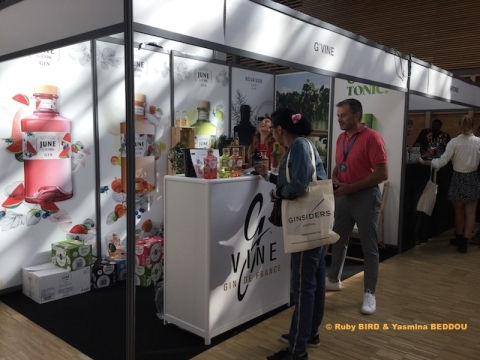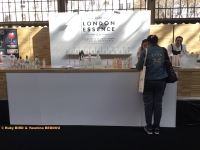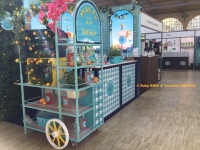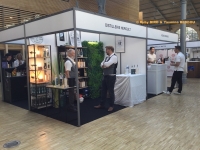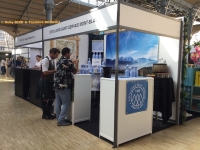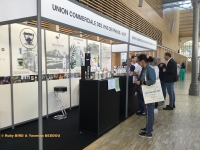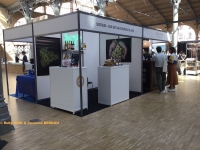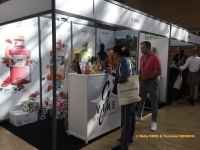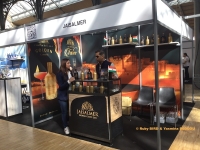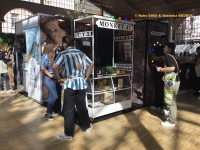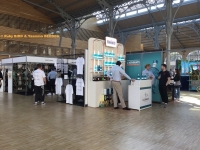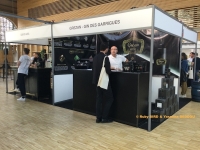Lifestyle
GINSIDERS FESTIVAL Returns To PARIS For A SECOND EDITION
AROUND THE WORLD OF GIN AND TONIC

GINSIDERS Festival (Source: © Ruby BIRD & Yasmina BEDDOU)
USPA NEWS -
Ginsiders Festival returns to Paris for a Second Edition! More than 200 International References around the World of GIN and TONIC. Big Names and Local Producers were present during 3 days (6-7-8 October 2023 in Carreau Du Temple in Paris). More than 15 Countries were represented.
Ginsiders Festival returns to Paris for a Second Edition! More than 200 International References around the World of GIN and TONIC. Big Names and Local Producers were present during 3 days (6-7-8 October 2023 in Carreau Du Temple in Paris). More than 15 Countries were represented.
- Gin Festival to enjoy a Unique Experience
* Taste
More than 200 References of Gin and Tonic from all over the world!
* Buy
Bottles of Gin and Tonic directly on the Stands.
* Learn
To know the History of the Brands and their Gins through Conferences.
* Discover
The world of GINTONIC and COCKTAIL during the Masterclass.
* Taste
More than 200 References of Gin and Tonic from all over the world!
* Buy
Bottles of Gin and Tonic directly on the Stands.
* Learn
To know the History of the Brands and their Gins through Conferences.
* Discover
The world of GINTONIC and COCKTAIL during the Masterclass.
- Where does Gin come from?
Its History begins in Flanders (the Current Netherlands) in the 17th Century under the Name of "Genever". Its Creation is often attributed to the Chemist and Physician Franciscus Sylvius. At the Time, it was a Cereal Brandy, generally made from Rye or Barley. It is flavored by maceration of Juniper Berries to mask the Defects of a still very rough Distillation. It is this Flemish Genever that will serve as a Model for English Gin a Century later.
Its History begins in Flanders (the Current Netherlands) in the 17th Century under the Name of "Genever". Its Creation is often attributed to the Chemist and Physician Franciscus Sylvius. At the Time, it was a Cereal Brandy, generally made from Rye or Barley. It is flavored by maceration of Juniper Berries to mask the Defects of a still very rough Distillation. It is this Flemish Genever that will serve as a Model for English Gin a Century later.
Indeed, it is during the Thirty Years War (1618-1648) that the English Soldiers fighting in Holland discovered a New Drink that they would soon bring back Home. Genever is commonly used as a Remedy for Heartburn, Gout or Pain caused by Gallstones. A Glassful was also served to Soldiers to galvanize them before Battle, and the English quickly acquired a Taste for this Elixir, which they called “Dutch Courage” once they returned Home.
This “Juniper Water” experienced a New Boom at the end of the 17th Century in England. It is called “Genever”, then “Jenever” and finally simply “Gin”. The Craze for this New Alcohol spreads beyond the Soldiers returning from Military Campaigns. This Success was accelerated by the Abolition of the Monopoly of the London Distillers’ Guild in 1690 with the Distilling Act.
Gin, which at its Inception was used for Medicinal Purposes, quickly becomes Recreational… and Dangerously Addictive. This Cheap, Domestic Brandy quickly became a Hit among the Urban Working Classes... It was not until the 19th Century that Gin acquired its Letters of Nobility in England.
In the 20th Century, Gin began to flourish: Advances in Distillation gave Manufacturers access to a Perfectly Neutral Base Spirit that no longer needed to be sweetened to mask Imperfections... The “London Dry” Style of Gin then became Prominent in the 1920s. The Rest of the Century was Chaotic: Prohibition in the United States, the Economic Crisis of 1929 and the Second World War followed.
Gin became Popular again in the 50s and 60s, Absolute Synonym of Style in Cocktails like the Iconic "Dry Martini," then slowly declined. The End of the 1990s and the Beginning of the 2000s saw the Beginnings of a True Renaissance of the Category, which first took Root in Europe and is now spreading throughout the World, thanks to the Rediscovery of the Personality and Versatility of this Spirit of Great Character.
- How is Gin made?
Gin is a Distilled and Flavored Spirit, mainly based on Neutral Alcohol, whose Predominant Flavor must be that of Juniper. It must be Bottled at a Minimum of 37.5% vol. What will give its Personality to this spirit, it is mainly its Aromatization. It can also be, more Rarely, its Alcoholic Base if, like some Modern Gins, it is not distilled from Neutral Alcohol.
Gin is a Distilled and Flavored Spirit, mainly based on Neutral Alcohol, whose Predominant Flavor must be that of Juniper. It must be Bottled at a Minimum of 37.5% vol. What will give its Personality to this spirit, it is mainly its Aromatization. It can also be, more Rarely, its Alcoholic Base if, like some Modern Gins, it is not distilled from Neutral Alcohol.
The Aromatic Plants used must always include Juniper, either Juniper Berries or an already Distilled Extract. Most Gins are made by distilling a Bouquet of Aromatic Plants in an Alcohol Base. The Distillation and Infusion Techniques vary, but the Fundamental Principle remains the same: the Essential Oils loaded with the Aromatic Principles of the Plants are extracted in contact with Alcohol.
Either the latter is in a Liquid State and the Aromatics are macerated directly in it, or in the Form of Vapors inside the Still if the Distiller has chosen the Method known as “Vapor Infusion”. Some Rarer Gins are not flavored by Distillation, but by Simple Infusion or by means of Aromatic Extracts added to an Alcohol Base.
- The History Of Tonic
Tonic Water is also called Tonic. It is a Soft Drink that contains Quinine, extracted from a Shrub. It is the latter that gives it this Slightly Bitter Taste.
Tonic Water is also called Tonic. It is a Soft Drink that contains Quinine, extracted from a Shrub. It is the latter that gives it this Slightly Bitter Taste.
Tonic was developed by French Pharmacists Pierre-Joseph Pelletier and Joseph Bienaimé Caventou. They were the First to isolate Quinine. Around 1780, Johann Jakob Schweppe, a Swiss Watchmaker and Chemistry Enthusiast, found a Method to charge Water with Carbon Dioxide. A Reaction is made by stirring Chalk and Sulfuric Acid. Gas is thus obtained, then recovered and put in a Heated Tank. While heating, the Mixture is stirred to create Pressure to gasify the Water.
Its Use grows in 1870. Indeed, in British India, Soldiers were prescribed to take Doses of the Prophylactic Quinine in order to fight Malaria, which was taking its Toll. However, Quinine is Very Bitter. It is then mixed with Sugar and Water to facilitate its Consumption. Schweppes was inspired by these Uses and added Quinine and Citrus Extracts to its Carbonated Water, which gave Birth to Indian Tonic.
- The History Of Gin and Tonic
The gin & tonic is a Cocktail composed of Gin, Tonic Water and Citrus Peel. It is said to have been first created in the 18th Century by Dutch and British Colonial Companies, but many believe this to be a Myth…
The gin & tonic is a Cocktail composed of Gin, Tonic Water and Citrus Peel. It is said to have been first created in the 18th Century by Dutch and British Colonial Companies, but many believe this to be a Myth…
This Cocktail actually comes from the Tonic Water that was used to fight Malaria. The Taste of Quinine was Too Bitter. Sugar and Alcohol were added to make it easier to take. The Combination of Gin and Tonic Water was a Taste Revelation and was democratized among the British Military and Colonists in the early 19th Century.
The Drink became very Popular and we remember Winston Churchill’s Famous Phrase: “Gin and Tonic has saved more English Lives and Souls than all the Doctors in the Empire”. Nowadays, Tonic Waters have gained in Quality and Diversity to compose Magnificent Matches with the Different Styles of Gin...
Source:
Ginsiders Festival - Paris Second Edition
@ Carreau du Temple (Heart of Paris, in the Trendy District of the Haut Marais)
On 6-7-8 October 2023
Ruby BIRD
http://www.portfolio.uspa24.com/
Yasmina BEDDOU
http://www.yasmina-beddou.uspa24.com/
Ginsiders Festival - Paris Second Edition
@ Carreau du Temple (Heart of Paris, in the Trendy District of the Haut Marais)
On 6-7-8 October 2023
Ruby BIRD
http://www.portfolio.uspa24.com/
Yasmina BEDDOU
http://www.yasmina-beddou.uspa24.com/
more information: https://ginsiders.com
Ruby Bird Yasmina Beddou Ginsiders Paris Gin Tonic Festival Second Edition Names World Producers Countries 3 Days International References Experience Recipes Carreau Du Temple
Liability for this article lies with the author, who also holds the copyright. Editorial content from USPA may be quoted on other websites as long as the quote comprises no more than 5% of the entire text, is marked as such and the source is named (via hyperlink).

